American vs Irish Community Comparison
COMPARE
American
Irish
Social Comparison
Social Comparison
Americans
Irish
3,435
SOCIAL INDEX
31.9/ 100
SOCIAL RATING
220th/ 347
SOCIAL RANK
6,960
SOCIAL INDEX
67.1/ 100
SOCIAL RATING
134th/ 347
SOCIAL RANK
Irish Integration in American Communities
The statistical analysis conducted on geographies consisting of 578,341,135 people shows a strong negative correlation between the proportion of Irish within American communities in the United States with a correlation coefficient (R) of -0.736. On average, for every 1% (one percent) increase in Americans within a typical geography, there is a decrease of 0.078% in Irish. To illustrate, in a geography comprising of 100,000 individuals, a rise of 1,000 Americans corresponds to a decrease of 77.5 Irish.
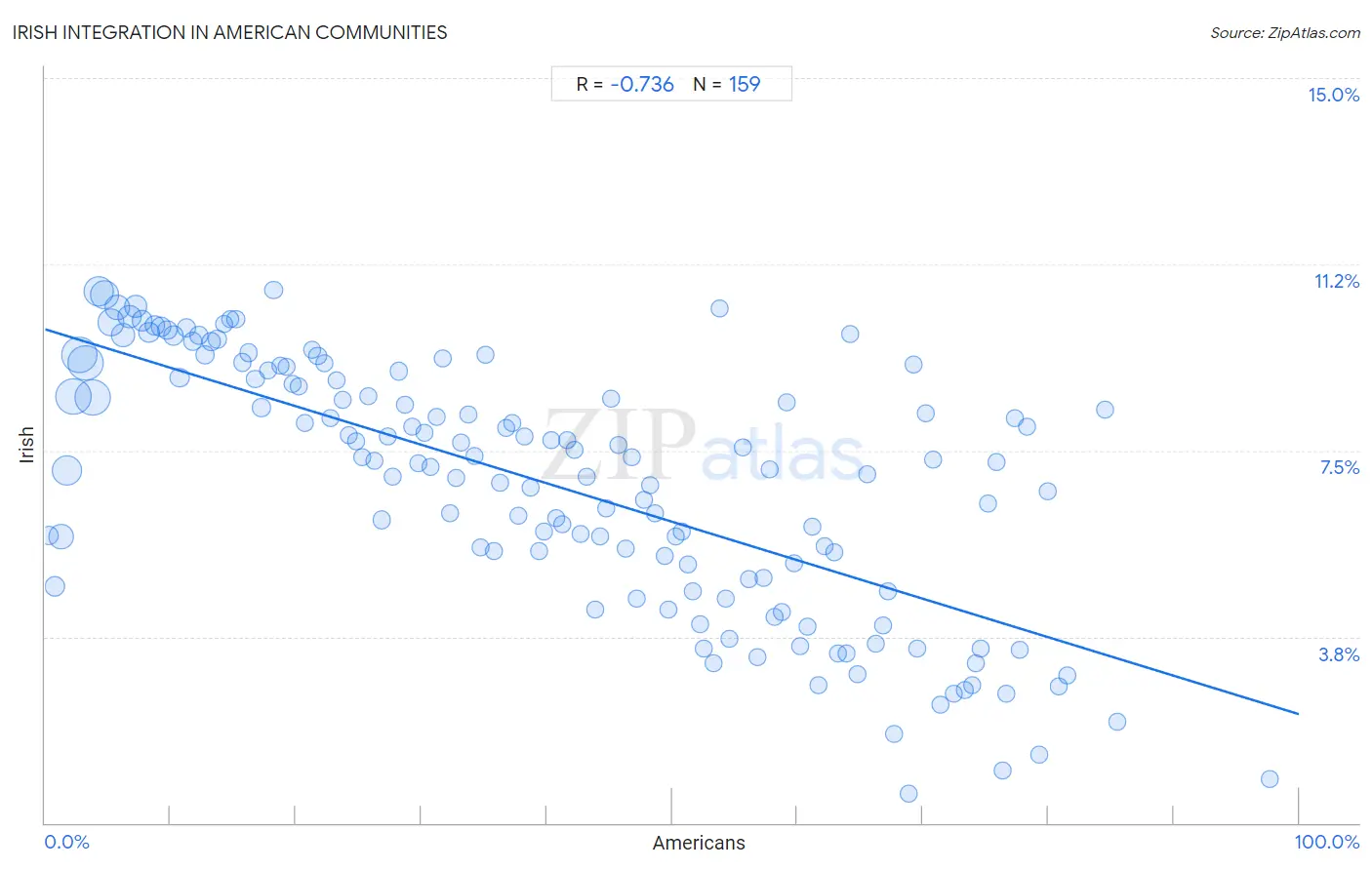
American vs Irish Income
When considering income, the most significant differences between American and Irish communities in the United States are seen in median family income ($92,096 compared to $105,453, a difference of 14.5%), per capita income ($39,039 compared to $44,679, a difference of 14.4%), and householder income ages 25 - 44 years ($84,791 compared to $96,730, a difference of 14.1%). Conversely, both communities are more comparable in terms of wage/income gap (27.8% compared to 28.5%, a difference of 2.3%), householder income under 25 years ($48,860 compared to $51,317, a difference of 5.0%), and median female earnings ($35,777 compared to $39,291, a difference of 9.8%).

| Income Metric | American | Irish |
| Per Capita Income | Tragic $39,039 | Good $44,679 |
| Median Family Income | Tragic $92,096 | Excellent $105,453 |
| Median Household Income | Tragic $75,932 | Good $86,145 |
| Median Earnings | Tragic $42,742 | Good $47,276 |
| Median Male Earnings | Tragic $50,761 | Excellent $56,464 |
| Median Female Earnings | Tragic $35,777 | Fair $39,291 |
| Householder Age | Under 25 years | Tragic $48,860 | Poor $51,317 |
| Householder Age | 25 - 44 years | Tragic $84,791 | Good $96,730 |
| Householder Age | 45 - 64 years | Tragic $90,536 | Good $103,067 |
| Householder Age | Over 65 years | Tragic $55,527 | Average $61,097 |
| Wage/Income Gap | Tragic 27.8% | Tragic 28.5% |
American vs Irish Poverty
When considering poverty, the most significant differences between American and Irish communities in the United States are seen in married-couple family poverty (5.3% compared to 4.2%, a difference of 26.8%), family poverty (9.8% compared to 7.9%, a difference of 24.4%), and child poverty under the age of 16 (18.3% compared to 14.9%, a difference of 22.9%). Conversely, both communities are more comparable in terms of female poverty among 18-24 year olds (21.6% compared to 20.1%, a difference of 7.2%), single father poverty (20.1% compared to 18.0%, a difference of 11.2%), and seniors poverty over the age of 75 (12.0% compared to 10.7%, a difference of 12.0%).
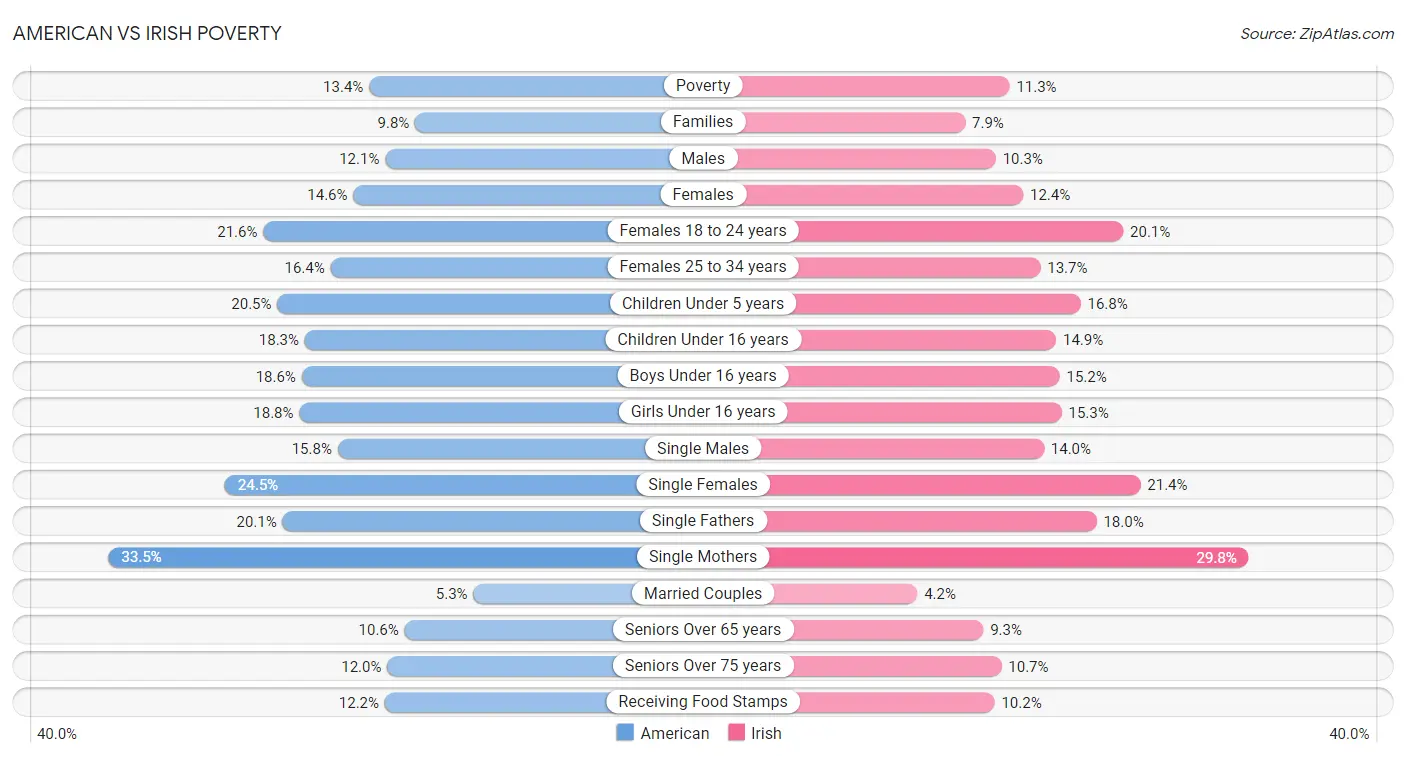
| Poverty Metric | American | Irish |
| Poverty | Tragic 13.4% | Exceptional 11.3% |
| Families | Tragic 9.8% | Exceptional 7.9% |
| Males | Tragic 12.1% | Exceptional 10.3% |
| Females | Tragic 14.6% | Exceptional 12.4% |
| Females 18 to 24 years | Tragic 21.6% | Average 20.1% |
| Females 25 to 34 years | Tragic 16.4% | Fair 13.7% |
| Children Under 5 years | Tragic 20.5% | Good 16.8% |
| Children Under 16 years | Tragic 18.3% | Exceptional 14.9% |
| Boys Under 16 years | Tragic 18.6% | Exceptional 15.2% |
| Girls Under 16 years | Tragic 18.8% | Exceptional 15.3% |
| Single Males | Tragic 15.8% | Tragic 14.0% |
| Single Females | Tragic 24.5% | Fair 21.4% |
| Single Fathers | Tragic 20.1% | Tragic 18.0% |
| Single Mothers | Tragic 33.5% | Poor 29.8% |
| Married Couples | Fair 5.3% | Exceptional 4.2% |
| Seniors Over 65 years | Good 10.6% | Exceptional 9.3% |
| Seniors Over 75 years | Good 12.0% | Exceptional 10.7% |
| Receiving Food Stamps | Fair 12.2% | Exceptional 10.2% |
American vs Irish Unemployment
When considering unemployment, the most significant differences between American and Irish communities in the United States are seen in unemployment among women with children under 6 years (9.3% compared to 8.1%, a difference of 14.3%), unemployment among ages 30 to 34 years (6.2% compared to 5.5%, a difference of 12.1%), and unemployment among women with children under 18 years (5.7% compared to 5.1%, a difference of 10.8%). Conversely, both communities are more comparable in terms of unemployment among seniors over 75 years (10.4% compared to 10.2%, a difference of 1.5%), unemployment among seniors over 65 years (5.2% compared to 5.1%, a difference of 2.2%), and unemployment among ages 55 to 59 years (4.8% compared to 4.7%, a difference of 3.0%).
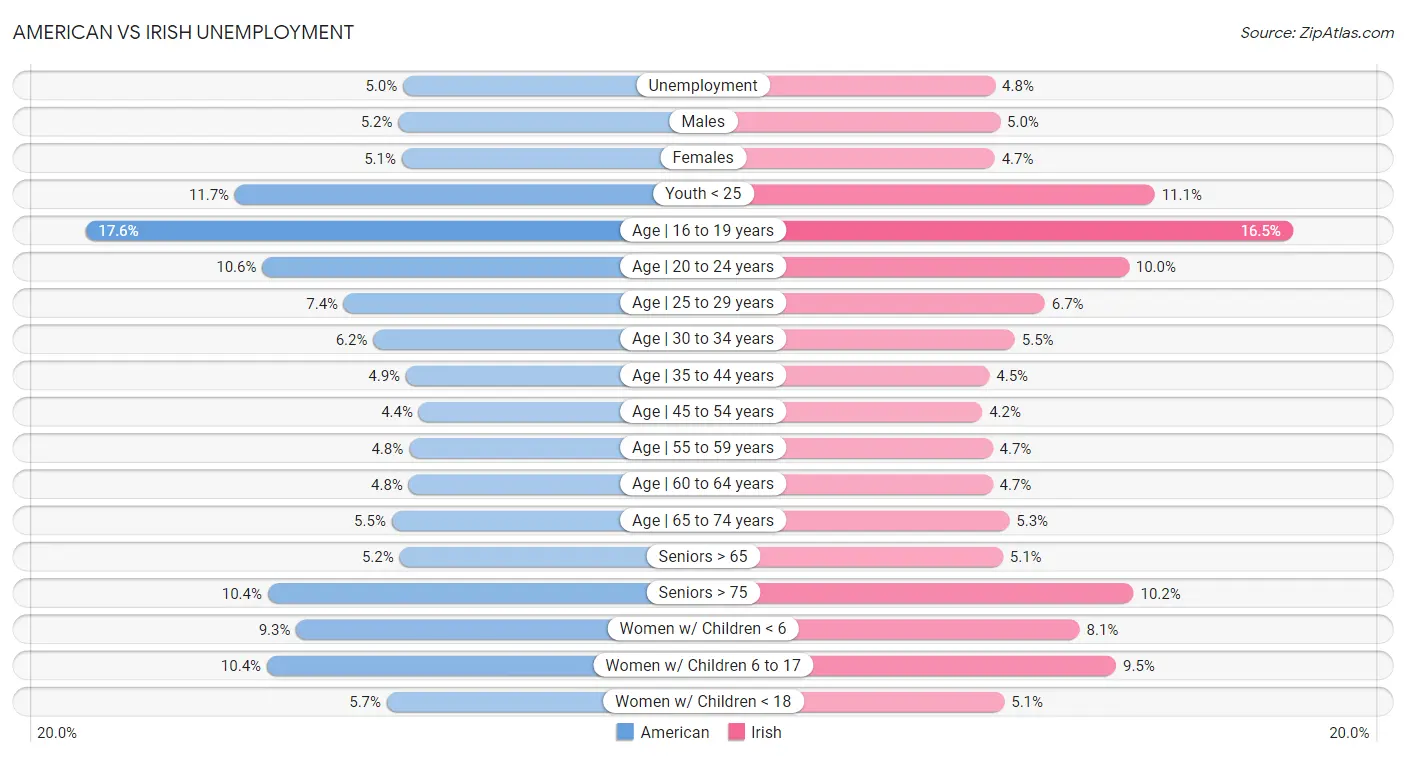
| Unemployment Metric | American | Irish |
| Unemployment | Exceptional 5.0% | Exceptional 4.8% |
| Males | Good 5.2% | Exceptional 5.0% |
| Females | Exceptional 5.1% | Exceptional 4.7% |
| Youth < 25 | Fair 11.7% | Exceptional 11.1% |
| Age | 16 to 19 years | Average 17.6% | Exceptional 16.5% |
| Age | 20 to 24 years | Tragic 10.6% | Exceptional 10.0% |
| Age | 25 to 29 years | Tragic 7.4% | Fair 6.7% |
| Age | 30 to 34 years | Tragic 6.2% | Fair 5.5% |
| Age | 35 to 44 years | Tragic 4.9% | Excellent 4.5% |
| Age | 45 to 54 years | Excellent 4.4% | Exceptional 4.2% |
| Age | 55 to 59 years | Good 4.8% | Exceptional 4.7% |
| Age | 60 to 64 years | Good 4.8% | Exceptional 4.7% |
| Age | 65 to 74 years | Tragic 5.5% | Good 5.3% |
| Seniors > 65 | Fair 5.2% | Excellent 5.1% |
| Seniors > 75 | Tragic 10.4% | Tragic 10.2% |
| Women w/ Children < 6 | Tragic 9.3% | Tragic 8.1% |
| Women w/ Children 6 to 17 | Tragic 10.4% | Tragic 9.5% |
| Women w/ Children < 18 | Tragic 5.7% | Exceptional 5.1% |
American vs Irish Labor Participation
When considering labor participation, the most significant differences between American and Irish communities in the United States are seen in in labor force | age 16-19 (40.3% compared to 42.0%, a difference of 4.1%), in labor force | age > 16 (62.1% compared to 64.1%, a difference of 3.2%), and in labor force | age 20-64 (77.0% compared to 79.3%, a difference of 2.9%). Conversely, both communities are more comparable in terms of in labor force | age 20-24 (76.1% compared to 77.4%, a difference of 1.7%), in labor force | age 25-29 (83.1% compared to 85.0%, a difference of 2.3%), and in labor force | age 35-44 (82.4% compared to 84.4%, a difference of 2.4%).

| Labor Participation Metric | American | Irish |
| In Labor Force | Age > 16 | Tragic 62.1% | Tragic 64.1% |
| In Labor Force | Age 20-64 | Tragic 77.0% | Poor 79.3% |
| In Labor Force | Age 16-19 | Exceptional 40.3% | Exceptional 42.0% |
| In Labor Force | Age 20-24 | Exceptional 76.1% | Exceptional 77.4% |
| In Labor Force | Age 25-29 | Tragic 83.1% | Exceptional 85.0% |
| In Labor Force | Age 30-34 | Tragic 82.7% | Average 84.7% |
| In Labor Force | Age 35-44 | Tragic 82.4% | Average 84.4% |
| In Labor Force | Age 45-54 | Tragic 80.4% | Fair 82.6% |
American vs Irish Family Structure
When considering family structure, the most significant differences between American and Irish communities in the United States are seen in births to unmarried women (36.4% compared to 32.2%, a difference of 13.0%), single mother households (6.6% compared to 5.8%, a difference of 13.0%), and single father households (2.4% compared to 2.3%, a difference of 6.0%). Conversely, both communities are more comparable in terms of married-couple households (47.9% compared to 48.6%, a difference of 1.4%), family households with children (27.3% compared to 26.8%, a difference of 1.6%), and family households (65.5% compared to 64.4%, a difference of 1.8%).

| Family Structure Metric | American | Irish |
| Family Households | Exceptional 65.5% | Average 64.4% |
| Family Households with Children | Fair 27.3% | Tragic 26.8% |
| Married-couple Households | Exceptional 47.9% | Exceptional 48.6% |
| Average Family Size | Tragic 3.16 | Tragic 3.10 |
| Single Father Households | Tragic 2.4% | Good 2.3% |
| Single Mother Households | Poor 6.6% | Exceptional 5.8% |
| Currently Married | Exceptional 48.0% | Exceptional 48.9% |
| Divorced or Separated | Tragic 13.2% | Tragic 12.5% |
| Births to Unmarried Women | Tragic 36.4% | Fair 32.2% |
American vs Irish Vehicle Availability
When considering vehicle availability, the most significant differences between American and Irish communities in the United States are seen in 4 or more vehicles in household (7.5% compared to 7.1%, a difference of 6.6%), 3 or more vehicles in household (22.6% compared to 21.8%, a difference of 4.0%), and no vehicles in household (7.7% compared to 7.4%, a difference of 2.9%). Conversely, both communities are more comparable in terms of 2 or more vehicles in household (60.0% compared to 60.1%, a difference of 0.060%), 1 or more vehicles in household (92.5% compared to 93.1%, a difference of 0.61%), and no vehicles in household (7.7% compared to 7.4%, a difference of 2.9%).

| Vehicle Availability Metric | American | Irish |
| No Vehicles Available | Exceptional 7.7% | Exceptional 7.4% |
| 1+ Vehicles Available | Exceptional 92.5% | Exceptional 93.1% |
| 2+ Vehicles Available | Exceptional 60.0% | Exceptional 60.1% |
| 3+ Vehicles Available | Exceptional 22.6% | Exceptional 21.8% |
| 4+ Vehicles Available | Exceptional 7.5% | Exceptional 7.1% |
American vs Irish Education Level
When considering education level, the most significant differences between American and Irish communities in the United States are seen in professional degree (3.6% compared to 4.4%, a difference of 23.6%), doctorate degree (1.5% compared to 1.9%, a difference of 23.4%), and master's degree (12.3% compared to 15.0%, a difference of 22.3%). Conversely, both communities are more comparable in terms of nursery school (98.4% compared to 98.6%, a difference of 0.21%), kindergarten (98.4% compared to 98.6%, a difference of 0.21%), and 1st grade (98.4% compared to 98.6%, a difference of 0.22%).
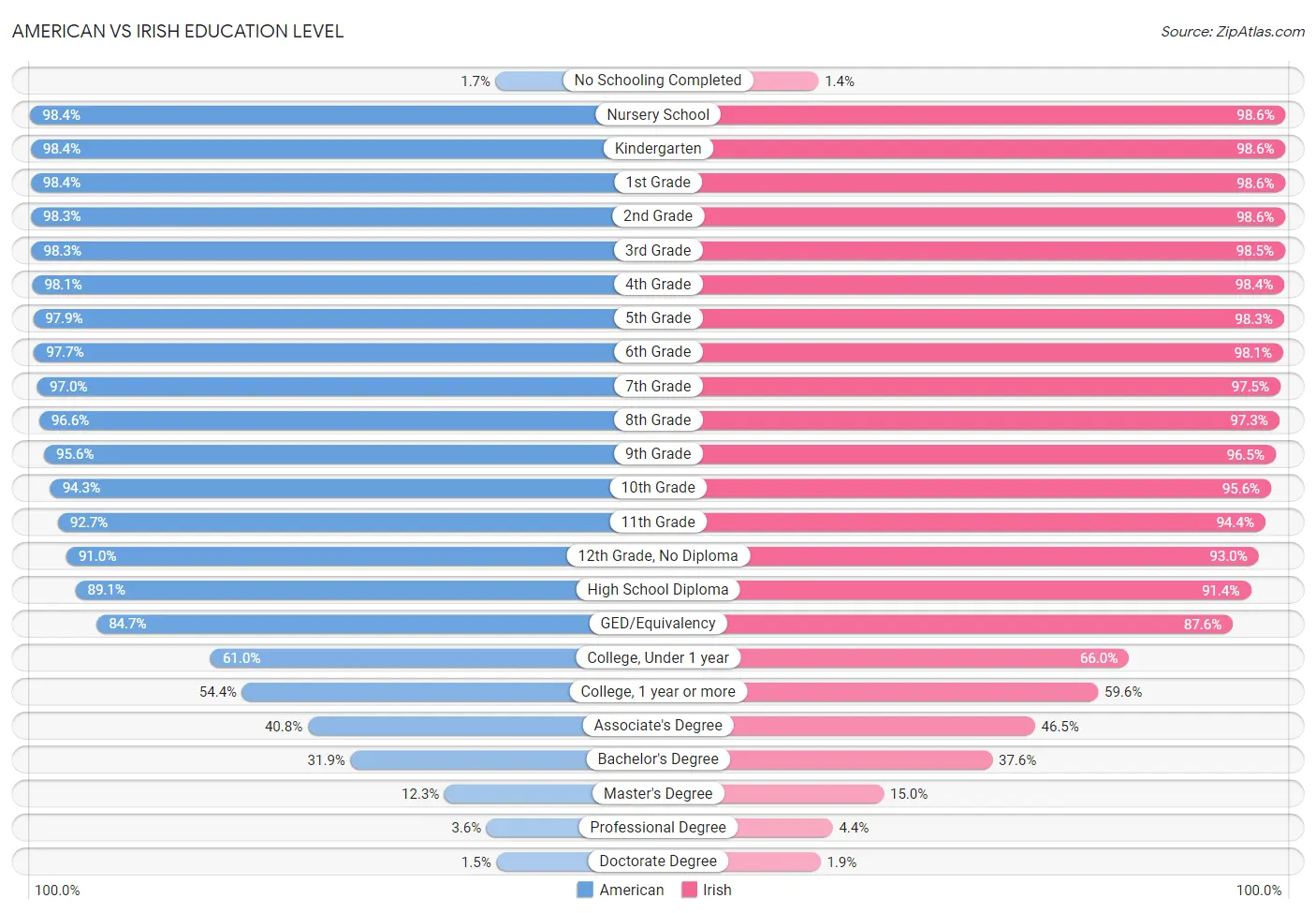
| Education Level Metric | American | Irish |
| No Schooling Completed | Exceptional 1.7% | Exceptional 1.4% |
| Nursery School | Exceptional 98.4% | Exceptional 98.6% |
| Kindergarten | Exceptional 98.4% | Exceptional 98.6% |
| 1st Grade | Exceptional 98.4% | Exceptional 98.6% |
| 2nd Grade | Exceptional 98.3% | Exceptional 98.6% |
| 3rd Grade | Exceptional 98.3% | Exceptional 98.5% |
| 4th Grade | Exceptional 98.1% | Exceptional 98.4% |
| 5th Grade | Exceptional 97.9% | Exceptional 98.3% |
| 6th Grade | Exceptional 97.7% | Exceptional 98.1% |
| 7th Grade | Exceptional 97.0% | Exceptional 97.5% |
| 8th Grade | Exceptional 96.6% | Exceptional 97.3% |
| 9th Grade | Exceptional 95.6% | Exceptional 96.5% |
| 10th Grade | Exceptional 94.3% | Exceptional 95.6% |
| 11th Grade | Good 92.7% | Exceptional 94.4% |
| 12th Grade, No Diploma | Fair 91.0% | Exceptional 93.0% |
| High School Diploma | Average 89.1% | Exceptional 91.4% |
| GED/Equivalency | Tragic 84.7% | Exceptional 87.6% |
| College, Under 1 year | Tragic 61.0% | Good 66.0% |
| College, 1 year or more | Tragic 54.4% | Average 59.6% |
| Associate's Degree | Tragic 40.8% | Average 46.5% |
| Bachelor's Degree | Tragic 31.9% | Average 37.6% |
| Master's Degree | Tragic 12.3% | Average 15.0% |
| Professional Degree | Tragic 3.6% | Average 4.4% |
| Doctorate Degree | Tragic 1.5% | Good 1.9% |
American vs Irish Disability
When considering disability, the most significant differences between American and Irish communities in the United States are seen in vision disability (2.6% compared to 2.3%, a difference of 16.2%), disability age 35 to 64 (13.9% compared to 12.3%, a difference of 13.0%), and ambulatory disability (7.4% compared to 6.6%, a difference of 12.9%). Conversely, both communities are more comparable in terms of cognitive disability (17.2% compared to 16.8%, a difference of 2.2%), disability age over 75 (48.4% compared to 46.5%, a difference of 4.1%), and disability age 18 to 34 (8.0% compared to 7.7%, a difference of 4.4%).
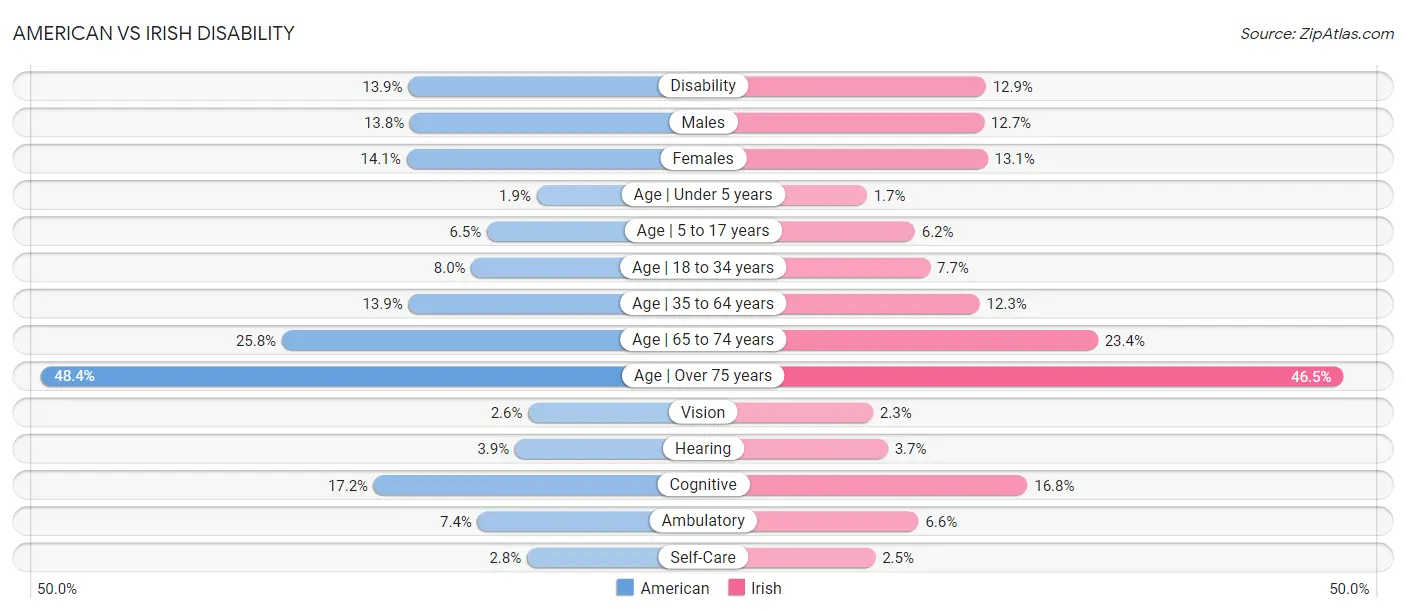
| Disability Metric | American | Irish |
| Disability | Tragic 13.9% | Tragic 12.9% |
| Males | Tragic 13.8% | Tragic 12.7% |
| Females | Tragic 14.1% | Tragic 13.1% |
| Age | Under 5 years | Tragic 1.9% | Tragic 1.7% |
| Age | 5 to 17 years | Tragic 6.5% | Tragic 6.2% |
| Age | 18 to 34 years | Tragic 8.0% | Tragic 7.7% |
| Age | 35 to 64 years | Tragic 13.9% | Tragic 12.3% |
| Age | 65 to 74 years | Tragic 25.8% | Average 23.4% |
| Age | Over 75 years | Tragic 48.4% | Exceptional 46.5% |
| Vision | Tragic 2.6% | Tragic 2.3% |
| Hearing | Tragic 3.9% | Tragic 3.7% |
| Cognitive | Good 17.2% | Exceptional 16.8% |
| Ambulatory | Tragic 7.4% | Tragic 6.6% |
| Self-Care | Tragic 2.8% | Fair 2.5% |